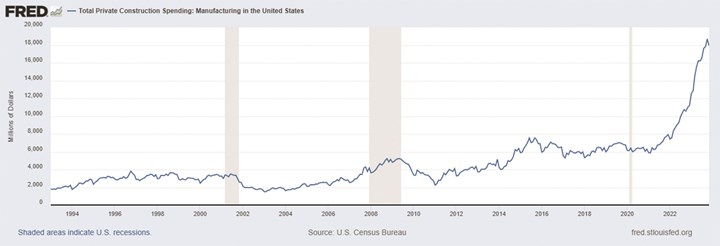Onshoring Weather Report: Strong Tailwinds!
Onshoring, reshoring, nearshoring: these terms are showing up with increasing frequency in the news and online. But is there evidence that these are real?
There can be little doubt that the return of manufacturing — and manufacturing jobs — to North America is happening. But what are the facts? How can we know that this is a real, sustainable trend worthy of our investment?
The Opportunity of Manufacturing
According to a report by Deloitte and the Manufacturing Institute, over the next decade, 4 million manufacturing jobs will likely be needed — and 2.1 million are expected to go unfilled — if we do not inspire more people to pursue modern manufacturing careers (bit.ly/PMPA-PM0324a).
Clearly, the potential for employment exists.
New Private Construction for Manufacturing
A look at new private construction for manufacturing is convincing. The hockey stick graph shown below represents investment in construction of new manufacturing facilities (bit.ly/PMPA-PM0324b). Total private construction spending for manufacturing in the United States was $18.867 billion in October 2023 — its all-time high. How many manufacturing jobs will result from this dramatic increase in manufacturing facility construction?
U.S. Census Bureau, Total Private Construction Spending: Manufacturing in the United States [PRMFGCON], retrieved from FRED, Federal Reserve Bank of St. Louis; https://fred.stlouisfed.org/series/PRMFGCON, January 30, 2024.
Source: Federal Reserve Economic Data (FRED)
Foreign Direct Investment
Foreign companies are investing in the U.S., and those investments result in jobs. Foreign direct investment (FDI) in U.S. manufacturing was $5,254.816 billion in 2022, according to the Bureau of Economic Analysis’ report “Direct Investment by Country and Industry 2022” (bit.ly/PMPA-PM0324c).
That investment is up almost 20% from 2019’s $4,398.763 billion in Manufacturing FDI. According to the report “FDI in Manufacturing 2017,” produced by Trade.gov, more than 2.4 million U.S. jobs in manufacturing are supported by FDI (bit.ly/PMPA-PM0324d).
FDI in manufacturing is a major force driving manufacturing employment in the U.S.
Supply Chains and Shipping Rates
Since the 2020 COVID-19 pandemic, the term “supply chain disruptions” has become an almost everyday phrase. While the pandemic is no longer the operative cause, Reuters reported on January 4, 2024, that “Rates for shipments from Asia to North America’s East Coast climbed 55% to $3,900 per 40-foot container. West Coast prices jumped 63% to more than $2,700 ahead of expected cargo diversions to avoid Red Sea-related issues.” While these are serious increases, they are nowhere near those fueled by the prior pandemic: “$14,000 per 40-foot container for Asia to North Europe and the Mediterranean and $22,000 for Asia to North America’s East Coast” (reut.rs/48T2FTv).
Rate increases like these are no longer acceptable to consumer pocketbooks already stretched by inflation. Buying (and manufacturing) local makes economic sense today, by reducing the direct costs of global shipping, as well as eliminating the costs of delays by events that delay the shipping process — weather, disease, labor disputes. The lack of a logical reason to purchase globally — in the face of so many opportunities for delay and freight cost increases — supports the idea that manufacturing in the U.S. is likely to continue its renaissance.
Boardroom Sentiment
Bank of America strategist, Savita Subramanian, posted a May 2023 note to clients that mentions of reshoring on earnings calls from S&P 500 CEOs have risen 128% year over year (cnb.cx/3vYoZMY). S&P 500 companies produce durable manufactured goods that need precision machined products to function — automotive, appliance and aerospace to name a few — so a mention by CEOs of these companies is certainly a forward-looking indicator of their intentions and actions in this space.
According to The Conference Board “Executive mentions of nearshoring/reshoring/onshoring in earnings calls and conferences are up 1,100% since the start of the pandemic” (bit.ly/PMPA-PM0324e). Up 1,100%. That’s convincing.
And they are the customers for what we make in our precision machining shops.
Chinese Manufacturing
Since 2001, when China became a member of the World Trade Organization, (WTO) China has been seen as the “workshop to the world.” This narrative has diminished as crises in real estate, high unemployment and a crackdown on its technology sector have dampened China’s growth, in addition to a shrinking population. According to Statista, China’s labor force peaked at 800.91 million in 2015; in 2022, it had declined to 768.63 million (bit.ly/PMPA-PM0324f).
Nor is Chinese labor a low-cost bargain. According to Global Data, “China’s labor cost index in 2021 stood at 138. The index recorded a growth of 2.8% in 2021 compared to the previous year. Between 2010-2021, the index in China increased by 37.9%” (bit.ly/PMPA-PM0324g). Up 37.98%.
China GDP is also declining, as its “share of Global GDP fell in dollar terms for the first time in 29 years,” according to NikkeiAsia (s.nikkei.com/48KxFVD).
What are the “strong tailwinds” pushing the onshoring, reshoring and nearshoring trend in manufacturing today? We see the strong boom in new construction for manufacturing as one. Increasing FDI counts as another. Chaos in supply chains and out of control shipping costs are another factor convincing executives to buy local.
Executives themselves continue to announce their plans to bring manufacturing back, and in China, the demographics and the economic data are showing that the economy may have peaked in terms of its output as a share of global GDP. And I haven’t even mentioned U.S. government investments, incentives and efforts to promote domestic production of semiconductor chips and other high-technology products.
These are strong tailwinds. I’m not a weather forecaster, but the data I am seeing leads me to believe that manufacturing and manufacturing employment will be strong for the foreseeable future.
About the Author
Miles Free III
Miles Free III is the PMPA Director of Industry Affairs with over 50 years of experience in the areas of manufacturing, quality and steelmaking. Miles’ podcast is at pmpa.org/podcast.
Email: mfree@pmpa.org — Website: pmpa.org.
Related Content
Keeping It In The Family — Succession Tips From Those Who Lived It | Part 1
PMPA members share some tips to avoid getting burned when passing the business torch from one family member to another.
Read MoreTurned and Polished Steel Barstock: How It Is Manufactured, How It Impacts Your Shop
Understanding the benefits provided by turned and polished steel barstock and its differences from cold-drawn steel barstock can help you and your team avoid unexpected performance issues.
Read MoreCraftsman Cribsheet No. 128: Why Do Machinists Say Tenths Instead of Ten Thousandths?
In machinist parlance, a tenth is a tenth of a thousandth, not a tenth of an inch.
Read More‘Can You Hold This Tolerance?’ Is Not An Engineering Question
The implications of tolerances go far beyond mere technical compliance.
Read MoreRead Next
5 Aspects of PMTS I Appreciate
The three-day edition of the 2025 Precision Machining Technology Show kicks off at the start of April. I’ll be there, and here are some reasons why.
Read MoreDo You Have Single Points of Failure?
Plans need to be in place before a catastrophic event occurs.
Read MoreA Tooling Workshop Worth a Visit
Marubeni Citizen-Cincom’s tooling and accessory workshop offers a chance to learn more about ancillary devices that can boost machining efficiency and capability.
Read More









.jpg;maxWidth=300;quality=90)












